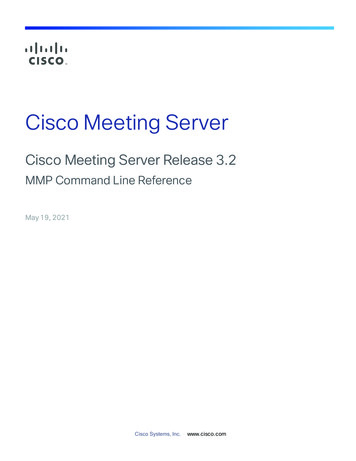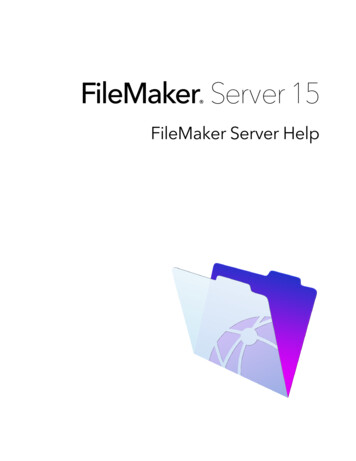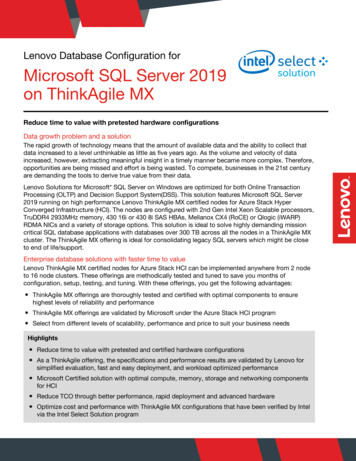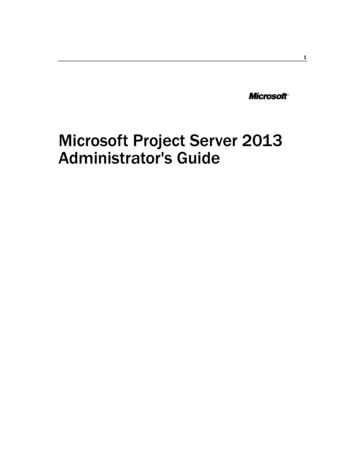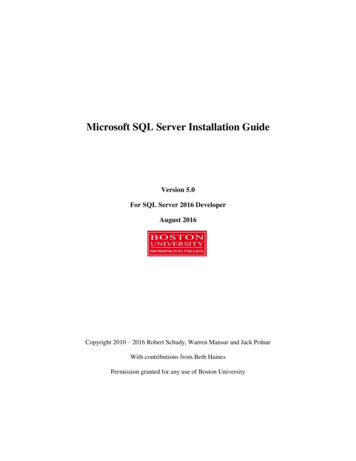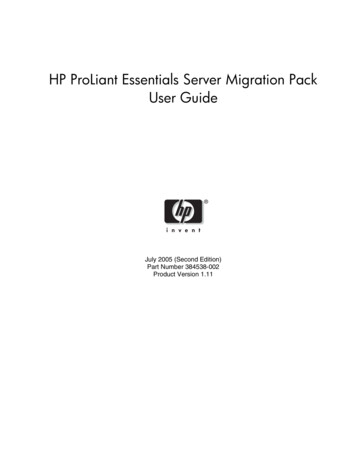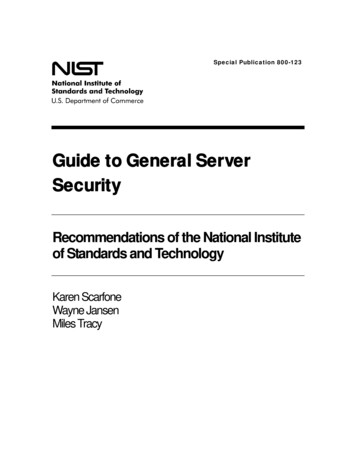
Transcription
Special Publication 800-123Guide to General ServerSecurityRecommendations of the National Instituteof Standards and TechnologyKaren ScarfoneWayne JansenMiles Tracy
NIST Special Publication 800-123Guide to General Server SecurityRecommendations of the NationalInstitute of Standards and TechnologyKaren ScarfoneWayne JansenMiles TracyC O M P U T E RS E C U R I T YComputer Security DivisionInformation Technology LaboratoryNational Institute of Standards and TechnologyGaithersburg, MD 20899-8930July 2008U.S. Department of CommerceCarlos M. Gutierrez, SecretaryNational Institute of Standards and TechnologyJames M. Turner, Deputy Director
GUIDE TO GENERAL SERVER SECURITYReports on Computer Systems TechnologyThe Information Technology Laboratory (ITL) at the National Institute of Standards and Technology(NIST) promotes the U.S. economy and public welfare by providing technical leadership for the nation’smeasurement and standards infrastructure. ITL develops tests, test methods, reference data, proof ofconcept implementations, and technical analysis to advance the development and productive use ofinformation technology. ITL’s responsibilities include the development of technical, physical,administrative, and management standards and guidelines for the cost-effective security and privacy ofsensitive unclassified information in Federal computer systems. This Special Publication 800-seriesreports on ITL’s research, guidance, and outreach efforts in computer security and its collaborativeactivities with industry, government, and academic organizations.National Institute of Standards and Technology Special Publication 800-123Natl. Inst. Stand. Technol. Spec. Publ. 800-123, 53 pages (Jul. 2008)Certain commercial entities, equipment, or materials may be identified in thisdocument in order to describe an experimental procedure or concept adequately.Such identification is not intended to imply recommendation or endorsement by theNational Institute of Standards and Technology, nor is it intended to imply that theentities, materials, or equipment are necessarily the best available for the purpose.ii
GUIDE TO GENERAL SERVER SECURITYAcknowledgementsThe authors, Karen Scarfone and Wayne Jansen of the National Institute of Standards and Technology(NIST) and Miles Tracy of Federal Reserve Information Technology, wish to thank their colleagues whoreviewed drafts of this document and contributed to its technical content. The authors would like toacknowledge Murugiah Souppaya, Tim Grance, and Jim St. Pierre of NIST, Robert Dutton of Booz AllenHamilton, and Kurt Dillard for their keen and insightful assistance throughout the development of thedocument. Special thanks also go to the security experts that provided feedback during the publiccomment period, particularly Dean Farrington (Wells Fargo), Joseph Klein (Command Information), Dr.Daniel Woodard (The Bionetics Corporation), and representatives from the Federal AviationAdministration.Much of the content of this publication was derived from NIST Special Publication 800-44 Version 2,Guidelines on Securing Public Web Servers, by Miles Tracy, Wayne Jansen, Karen Scarfone, andTheodore Winograd, and NIST Special Publication 800-45 Version 2, Guidelines on Electronic MailSecurity, by Miles Tracy, Wayne Jansen, Karen Scarfone, and Jason Butterfield.iii
GUIDE TO GENERAL SERVER SECURITYTable of ContentsExecutive Summary.ES-11.Introduction .1-11.11.21.31.42.Background .2-12.12.22.32.43.3.33.43.54.34.4Patch and Upgrade Operating System .4-1Hardening and Securely Configuring the OS.4-24.2.1 Remove or Disable Unnecessary Services, Applications, and NetworkProtocols .4-24.2.2 Configure OS User Authentication .4-44.2.3 Configure Resource Controls Appropriately .4-6Install and Configure Additional Security Controls .4-6Security Testing the Operating System .4-7Securing the Server Software .5-15.15.25.35.46.Installation and Deployment Planning.3-1Security Management Staff.3-33.2.1 Chief Information Officer.3-43.2.2 Information Systems Security Program Managers .3-43.2.3 Information Systems Security Officers .3-43.2.4 Server, Network, and Security Administrators.3-5Management Practices .3-5System Security Plan.3-6Human Resources Requirements .3-7Securing the Server Operating System .4-14.14.25.Server Vulnerabilities, Threats, and Environments .2-1Security Categorization of Information and Information Systems .2-2Basic Server Security Steps .2-3Server Security Principles.2-4Server Security Planning.3-13.13.24.Authority.1-1Purpose and Scope .1-1Audience .1-2Document Structure .1-2Securely Installing the Server Software .5-1Configuring Access Controls.5-2Server Resource Constraints.5-3Selecting and Implementing Authentication and Encryption Technologies .5-4Maintaining the Security of the Server.6-16.16.2Logging .6-16.1.1 Identifying Logging Capabilities and Requirements .6-16.1.2 Reviewing and Retaining Log Files .6-26.1.3 Automated Log File Analysis Tools .6-3Server Backup Procedures .6-46.2.1 Server Data Backup Policies .6-4iv
GUIDE TO GENERAL SERVER SECURITY6.36.46.56.2.2 Server Backup Types .6-56.2.3 Maintain a Test Server .6-6Recovering From a Security Compromise .6-6Security Testing Servers.6-86.4.1 Vulnerability Scanning .6-96.4.2 Penetration Testing .6-10Remotely Administering a Server .6-11AppendicesAppendix A— Glossary . A-1Appendix B— Acronyms and Abbreviations . B-1Appendix C— Resources . C-1v
GUIDE TO GENERAL SERVER SECURITYExecutive SummaryAn organization’s servers provide a wide variety of services to internal and external users, and manyservers also store or process sensitive information for the organization. Some of the most common typesof servers are Web, email, database, infrastructure management, and file servers. This publicationaddresses the general security issues of typical servers.Servers are frequently targeted by attackers because of the value of their data and services. For example,a server might contain personally identifiable information that could be used to perform identity theft.The following are examples of common security threats to servers:Malicious entities may exploit software bugs in the server or its underlying operating system to gainunauthorized access to the server.Denial of service (DoS) attacks may be directed to the server or its supporting network infrastructure,denying or hindering valid users from making use of its services.Sensitive information on the server may be read by unauthorized individuals or changed in anunauthorized manner.Sensitive information transmitted unencrypted or weakly encrypted between the server and the clientmay be intercepted.Malicious entities may gain unauthorized access to resources elsewhere in the organization’s networkvia a successful attack on the server.Malicious entities may attack other entities after compromising a server. These attacks can belaunched directly (e.g., from the compromised host against an external server) or indirectly (e.g.,placing malicious content on the compromised server that attempts to exploit vulnerabilities in theclients of users accessing the server).This document is intended to assist organizations in installing, configuring, and maintaining secureservers. More specifically, this document describes, in detail, the following practices to apply:Securing, installing, and configuring the underlying operating systemSecuring, installing, and configuring server softwareMaintaining the secure configuration through application of appropriate patches and upgrades,security testing, monitoring of logs, and backups of data and operating system files.The following key guidelines are recommended to Federal departments and agencies for maintaining asecure server.Organizations should carefully plan and address the security aspects of the deployment of a server.Because it is much more difficult to address security once deployment and implementation have occurred,security should be carefully considered from the initial planning stage. Organizations are more likely tomake decisions about configuring computers appropriately and consistently when they develop and use adetailed, well-designed deployment plan. Developing such a plan will support server administrators inmaking the inevitable tradeoff decisions between usability, performance, and risk.ES-1
GUIDE TO GENERAL SERVER SECURITYOrganizations often fail to consider the human resource requirements for both deployment andoperational phases of the server and supporting infrastructure. Organizations should address thefollowing points in a deployment plan:Types of personnel required (e.g., system and server administrators, network administrators,information systems security officers [ISSO])Skills and training required by assigned personnelIndividual (i.e., level of effort required of specific personnel types) and collective staffing (i.e.,overall level of effort) requirements.Organizations should implement appropriate security management practices and controls whenmaintaining and operating a secure server.Appropriate management practices are essential to operating and maintaining a secure server. Securitypractices entail the identification of an organization’s information system assets and the development,documentation, and implementation of policies, standards, procedures, and guidelines that help to ensurethe confidentiality, integrity, and availability of information system resources. To ensure the security of aserver and the supporting network infrastructure, the following practices should be implemented:Organization-wide information system security policyConfiguration/change control and managementRisk assessment and managementStandardized software configurations that satisfy the information system security policySecurity awareness and trainingContingency planning, continuity of operations, and disaster recovery planningCertification and accreditation.Organizations should ensure that the server operating system is deployed, configured, andmanaged to meet the security requirements of the organization.The first step in securing a server is securing the underlying operating system. Most commonly availableservers operate on a general-purpose operating system. Many security issues can be avoided if theoperating systems underlying servers are configured appropriately. Default hardware and softwareconfigurations are typically set by manufacturers to emphasize features, functions, and ease of use, at theexpense of security. Because manufacturers are not aware of each organization’s security needs, eachserver administrator must configure new servers to reflect their organization’s security requirements andreconfigure them as those requirements change. Using security configuration guides or checklists canassist administrators in securing servers consistently and efficiently. Securing an operating systeminitially would generally include the following steps:Patch and upgrade the operating systemRemove or disable unnecessary services, applications, and network protocolsConfigure operating system user authenticationES-2
GUIDE TO GENERAL SERVER SECURITYConfigure resource controlsInstall and configure additional security controls, if neededPerform security testing of the operating system.Organizations should ensure that the server application is deployed, configured, and managed tomeet the security requirements of the organization.In many respects, the secure installation and configuration of the server application will mirror theoperating system process discussed above. The overarching principle is to install the minimal amount ofservices required and eliminate any known vulnerabilities through patches or upgrades. If the installationprogram installs any unnecessary applications, services, or scripts, they should be removed immediatelyafter the installation process concludes. Securing the server application would generally include thefollowing steps:Patch and upgrade the server applicationRemove or disable unnecessary services, applications, and sample contentConfigure server user authentication and access controlsConfigure server resource controlsTest the security of the server application (and server content, if applicable).Many servers also use authentication and encryption technologies to restrict who can access the serverand to protect information transmitted between the server and its clients. Organizations shouldperiodically examine the services and information accessible on the server and determine the necessarysecurity requirements. Organizations should also be prepared to migrate their servers to strongercryptographic technologies as weaknesses are identified in the servers’ existing cryptographictechnologies. For example, NIST has recommended that use of the Secure Hash Algorithm 1 (SHA-1) bephased out by 2010 in favor of SHA-224, SHA-256, and other larger, stronger hash functions.Organizations should stay aware of cryptographic requirements and plan to update their serversaccordingly.Organizations should commit to the ongoing process of maintaining the security of servers toensure continued security.Maintaining a secure server requires constant effort, resources, and vigilance from an organization.Securely administering a server on a daily basis is an essential aspect of server security. Maintaining thesecurity of a server will usually involve the following actions:Configuring, protecting, and analyzing log files on an ongoing and frequent basisBacking up critical information frequentlyEstablishing and following procedures for recovering from compromiseTesting and applying patches in a timely mannerTesting security periodically.ES-3
GUIDE TO GENERAL SERVER SECURITY1.Introduction1.1AuthorityThe National Institute of Standards and Technology (NIST) developed this document in furtherance of itsstatutory responsibilities under the Federal Information Security Management Act (FISMA) of 2002,Public Law 107-347.NIST is responsible for developing standards and guidelines, including minimum requirements, forproviding adequate information security for all agency operations and assets; but such standards andguidelines shall not apply to national security systems. This guideline is consistent with the requirementsof the Office of Management and Budget (OMB) Circular A-130, Section 8b(3), “Securing AgencyInformation Systems,” as analyzed in A-130, Appendix IV: Analysis of Key Sections. Supplementalinformation is provided in A-130, Appendix III.This guideline has been prepared for use by Federal agencies. It may be used by nongovernmentalorganizations on a voluntary basis and is not subject to copyright, though attribution is desired.Nothing in this document should be taken to contradict standards and guidelines made mandatory andbinding on Federal agencies by the Secretary of Commerce under statutory authority, nor should theseguidelines be interpreted as altering or superseding the existing authorities of the Secretary of Commerce,Director of the OMB, or any other Federal official.1.2Purpose and ScopeThe purpose of this document is to assist organizations in understanding the fundamental activitiesperformed as part of securing and maintaining the security of servers that provide services over networkcommunications as a main function. Hosts that incidentally provide one or a few services formaintenance or accessibility purposes, such as a remote access service for remote troubleshooting, are notconsidered servers in this document. The types of servers this publication addresses include outwardfacing publicly accessible servers, such as web and email services, and a wide range of inward-facingservers. This document discusses the need to secure servers and provides recommendations for selecting,implementing, and maintaining the necessary security controls.This document addresses common servers that use general operating systems (OS) such as Unix, Linux,and Windows. Many of the recommendations in this document may also be applicable to servers that usespecialized OSs or run on proprietary
Securing, installing, and configuring the underlying operating system Securing, installing, and configuring server software Maintaining the secure configuration through a pplication of appropriate patches and upgrades, security testing, monitoring of logs, and bac




